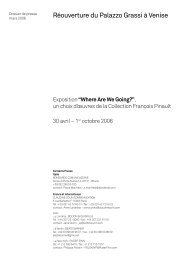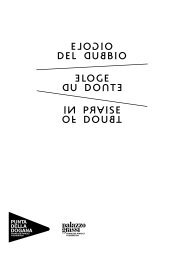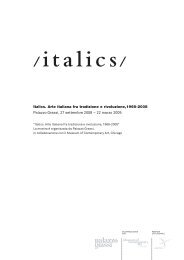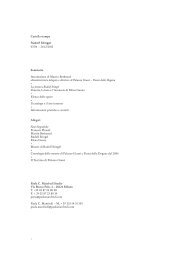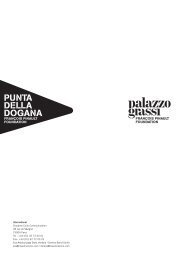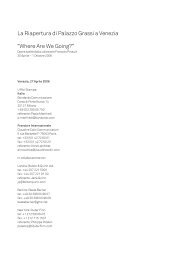pdf file, 819 Kb - Palazzo Grassi
pdf file, 819 Kb - Palazzo Grassi
pdf file, 819 Kb - Palazzo Grassi
You also want an ePaper? Increase the reach of your titles
YUMPU automatically turns print PDFs into web optimized ePapers that Google loves.
working them to the bone - or, quite simply, to push them back, and even slaughter the crowd of Goths who tried<br />
to cross over at all costs. It was no longer a case of delimiting an unspecified “tolerance level”, but of trying to<br />
survive a human flood they just seemed unable to hold back.<br />
To make a long story short, let us say that, what with the force of despair of the barbarian warriors, the dillydallying<br />
of the emperor, urgently returned from Syria, and the strategic mistakes made by his generals, it was<br />
not long before the scales tipped in favour of the barbarians: after the battle of Ad Salices and, even more so,<br />
that of Adrianople - on 9 August 378 -, the die was cast. Emperor Valens was killed in the fray, the legions, the<br />
very flower of the Roman army, were hacked to pieces by the barbarian cavalry and only the fortified citadels,<br />
as well as some of the large cities, escaped conquest by the Goths, now on their way to Rome, sacked in 410 by<br />
their chieftain Alaric. Finally, in 476, exactly one century after the first shockwaves had hit, the curtain fell on the<br />
Empire when the barbarian king Odoacer deposed Romulus Augustus, the last Western Roman emperor.<br />
The worst appeared to be done, at least in the terms of a Manichean and reactionary history that still has its<br />
supporters today: the Empire had allegedly disintegrated under the blows of the Goths, and the civilized populations,<br />
victims of their own leniency – too bad “all these brutes” had not been exterminated right from the start<br />
of the uprisings, when one had the means to! – had been struck down by the barbarian beasts. Such an account<br />
of hatred and terror of “the other”, had it been confirmed by facts, would have largely facilitated the task of the<br />
chief curator of our exhibition: “Rome and the Barbarians” would only have to show a pool of dried blood, some<br />
bones and the ashes of a genocide!<br />
Of course, everyone can see that nothing of the kind happened. On the contrary: far from being “the end of all<br />
things”, this changeover constitutes the starting point of a new history and this beneficial migration, as badly<br />
managed as it was then, constitutes an essential part of the richness of Western civilization. The West had already<br />
been abandoned to itself, and to “its” barbarians, by a Byzantine Empire that was fighting hard to survive,<br />
and was by now more distant than ever. But a new word, one that was to produce in Europe as many effects as<br />
the military conquests, if not more, finally prevailed: integration, the promise of a new world.<br />
It is this melting pot and the first faltering steps towards the mingling of different cultures, taking place at the<br />
four corners of the old Empire, that the <strong>Palazzo</strong> <strong>Grassi</strong> exhibition intends to illustrate. It will show the barbarian<br />
line, always in motion, gain a foothold in Roman representational patterns in fabric design – like the splendid<br />
embroidered chasuble of Queen Bathilde -, the interlacing ornamentation of goldsmith works, the jewels - the<br />
Merovingian grave of the “Lady” of Grez-Doiceau, near Brussels, in the Walloon Brabant, offers some exceptional<br />
findings - and the illuminations of the manuscripts. It will show the barbarian expansion coming to disrupt, at<br />
the speed of a galloping horse, the orderly pattern of the biaxial crossings, quadrangular plans and the squares<br />
and checks motifs on Roman tunics, silver platters, swords or buckles, while at the same time the Gothic warriors<br />
wreak havoc on the order of battle of the legions and uproot the markers of the Roman cadastre. It will<br />
show, as on the casket of Theuderic (mid-7th century), this portable treasure of the Abbey of Saint Maurice in<br />
the alpine Valais, the decoration “. On the front and sides with plates of cloisonné gold covered with welded<br />
bead-like gold tracery, crimped back to form the setting vitreous paste gems and garnets.<br />
Where are we then? In the Teutonic forests? In the workshops of ancient Rome? I prefer to say: in this new place,<br />
animated by a new faith and a yet-unborn imagery, where one, the Roman, would certainly not have gone without<br />
the other, the Barbarian.<br />
Monique Veaute






